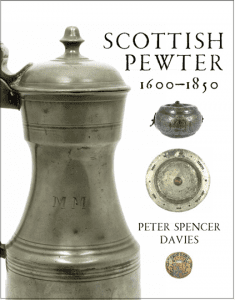Davies, P S (2014) “Scottish Pewter, 1600 – 1850”. Edinburgh: John Donald. hbk 324pp. 250 colour and 395 b&w illustrations. RRP £55.00 ISBN 978 1 9065 6672 2 reviewed by A.M. Allen
Pewter was an integral part of the Scotland’s material culture throughout the medieval and early modern periods. For most of the twentieth century, the standard work on Scottish pewter was L. Ingleby Wood’s seminal book, Scottish Pewter-ware and Pewterers. Whilst Wood’s praiseworthy tome has been a key reference work since 1905, there has always remained much more to be said on the topic of pewter, and this new study goes some distance in advancing our understanding of both the medium and its meaning. Scottish Pewter, 1600 – 1850 is written by Dr Peter Spencer Davies, who is a Fellow of the Society of Antiquaries of Scotland, a former biologist at the University of Glasgow and a former President of the Pewter Society. He has published widely on pewter, giving solid research foundations to this, his most recent study. It is beautifully produced, and whether your interests lie in the objects themselves or the socio-economic history behind their production and consumption, the stunning visuals and thorough scholarship have much to offer.
In addition to the comprehensive glossary, bibliography and indices, Scottish Pewter is divided up into ten chapters, with fourteen appendices interspersed throughout the book. The preface gives a general overview and explains certain specialist concepts such as the ‘pewterer’ as an occupational identifier, or the associated labels of ‘freemen’, ‘master’ and ‘journeyman’, with their implications for the right to work at a trade. For the reader who might not be familiar with the jargon and historiography of urban trades and material culture, this is a very useful explanation of the context for these exquisite artefacts. Makers’ marks, as valuable sources for the historian and antiquarian, and issues related to capacity are also touched on, before moving into the first chapter’s introduction of the role of pewter itself as an important material for the period.
The craftsmen are the focus of the next part of the book. Chapters two to four explore the craft of the pewterer, with particular reference to Edinburgh, which was producing pewter vessels by at least 1496. The fourth chapter explores what Davies refers to as ‘the provincial hammermen’s incorporations’, looking first at larger centres of production, including Glasgow, Paisley, Aberdeen, Inverness, Tain, Perth, and Dundee. The chapter continues with the ‘minor pewter-making’ centres, such as St Andrews, Canongate, Stirling, Dunfermline, and Haddington, demonstrating through its considerable geographical coverage the breadth of the work undertaken for this study.
The third part of the book looks at the products of the pewderer craft through six more chapters, with chapters five and six taking a chronological approach to church pewter, and chapters seven and eight exploring measures in a similar fashion. Following on from these, chapter nine looks at the ubiquitous tankards and tavern pots, which are so crucial to the material culture of conviviality in Scotland’s burghs, and the final tenth chapter covers ‘domestic and other pewter wares’, looking at such items as candle moulds and quaichs.
The appendices are as rich as they are varied, with the three main sections incorporating a beautifully-illustrated pictorial guide to makers’ marks, a brief guide to capacities of Scottish measures and a note on the care and conservation of old pewter. In addition to these, various material has also been appended to specific chapters. For example, chapter two is followed by two appendices on the composition of Scottish pewter and examples of legislation meant to regulate the quality of the metal used. The third chapter is followed by four appendices on the craftsmen, their touchplates, and the business addresses of those pewterers listed in eighteenth- and nineteenth-century directories. Further appendices are included for Glasgow pewterers after chapter four, whilst legislation in regards to capacity of Scottish measures follows chapter seven, highlighting the thoroughness of Davies’ research, as well as the usefulness of this study for the scholar.
Increasingly, historians are coming to recognise the value of material culture as a source for the study of the past; a shift which might rightly be described as a ‘material turn’ in the historiography, looking to the physical artefacts for a window into the past, and learning from our colleagues in anthropology and archaeology. The value of this approach is perhaps exemplified by Davies’ use of the pewter touchplates to identify previously unknown craftsmen (page 46), which turned out to be suburban artisans rather than burgh freemen, shedding further light on the ‘suburbanization’ of Edinburgh’s neighbouring settlements. Whilst many are happy to dismiss objects as merely illustrative of the past, Davies has demonstrated their usefulness as primary sources when used in conjunction with the surviving texts. In terms of textual sources, not only has Davies made use of the rich printed sources, such as acts of parliament, burgh records, craft registers, directories and numerous other volumes, but he has also done archival work with manuscript sources, looking at court records, craft minutes, and estate records.
This study, aside from being beautifully produced and richly illustrated, advances our understanding of the production and consumption of this crucial material. Certain elements of the technology, known to have been practised on the continent, such as the use of human power to turn the pewterers’ lathes, have now been firmly linked to Scotland’s artisans (page 40), whilst the broader historiography of pewter, building on the work of Wood and others, has been brought firmly into the twenty-first century. This is a delightful exploration of Scottish pewter, updating Wood’s classic study, and setting a new standard for this century. What Wood’s book was for the twentieth century, Davies’ work will no doubt be for the next hundred years.
Dr A.M. Allen FSA Scot, University of Edinburgh
Aaron published the book The Locksmith Craft in Early Modern Edinburgh with the Society of Antiquaries of Scotland in 2007

